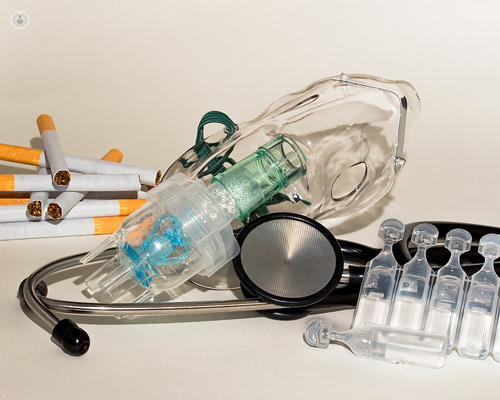Part 2: Chronic obstructive pulmonary disease (COPD): prognosis and treatment
Written by:Chronic obstructive pulmonary disease (COPD) is a term that is used for conditions that hinder the functionality of the lungs and cause breathing difficulties as a result. Previously, esteemed consultant pulmonologist Professor Indranil Chakravorty explained how COPD affects the body. In our most recent article, the Hitchin-based consultant explains the stages, prognosis, and treatment available to patients.

What are the different stages of COPD?
COPD is classified into four stages. Globally, there is an obstructive lung disease consensus, called the gold strategy. In the UK, there are also NICE COPD guidelines, which categorise the disease into five grades. These guidelines go from the early stages (stage 1), such as when patients have a cough, some phlegm, but no structural damage to the lungs, to the advanced stages (stage 4), symptoms of which include bronchitis, emphysema, complications to the skeletal muscles, and heart failure.
What is the prognosis?
The prognosis is determined by the severity of the disease. For people with early-stage COPD, the prognosis is normal. Stage zero to stage one patients will tend to have a normal lifespan unless they continue to smoke or be exposed to noxious stimuli, such as air pollution.
Stage two and three patients will have a reduced lifespan, by approximately five to seven years. Even with treatment, COPD is a progressive disease. There are two things a patient can do to improve their prognosis. The first is avoiding smoking and inhaling harmful substances, which can improve one’s prognosis by about 20-25%. The second is exercise, which improves skeletal muscle function.
At stage three or four, the prognosis is significantly affected. Failure of the cardiovascular and respiratory systems reduced the oxygen capacity, and because of this, only 20-30% of patients with stage 4, advanced COPD will survive five years. What affects survival in those patients is the progression of heart failure, the loss of function due to skeletal muscle loss, and the frequency of infections.
What are the treatment options?
The treatment options are broadly divided into three brackets. The first is what we can do to prevent the progression of the disease, the second is how we can manage symptoms and, the third is how we can prevent long-term complications.
The first step is the prevention of progression. For that, the number one thing to do is to change one's lifestyle and stop exposure to things we know causes progression. That means quitting smoking, avoiding areas with a lot of air pollution, and exercising regularly. These are usually covered in pulmonary rehabilitation programmes, which also educate people on the disease, helping people understand how it functions, and how they can reduce its impact.
Secondly is the management of symptoms, mainly breathlessness which is treated mostly with inhalers, which can be short-acting or long-acting ones. Additionally, exacerbation, when inflammation peaks, needs to be prevented. Exacerbations can be either infectious, caused by viruses or bacteria, or non-infectious, caused by changing weather or pollution, but each one needs to be treated. Normally, steroids are used to reduce inflammation. As exacerbations last about two to three weeks, the course of steroids will last at least three weeks. Antibiotics can be used alongside steroids.
If a patient experiences more than two exacerbations a year, they tend to be put on regular, long-term steroid inhalers as prevention. This, however, is not necessary for people who experience exacerbations less than once a year.
Finally, the prevention of complications, caused by heart failure and pulmonary hypertension. Patients in advanced stages tend to develop hypoxia or low oxygen levels, which causes constriction of the pulmonary vessels eventually leading to heart failure. For this reason, the oxygen saturation levels are monitored, and if they fall below 92%, the risk of pulmonary hypertension increases. Supplemented oxygen is given as a preventative treatment and if there are no signs of heart failure, diuretics, which are tablets that help rid the body of salt and water, will be given.
Have there been recent improvements in treatment?
The biggest breakthrough in terms of treating COPD is the use of long-acting bronchodilators, a type of combination inhaler that has two or three drugs in it. These inhalers have made it easier for people to take them. Instead of using three inhalers, three or four times a day, a patient takes one once a day, allowing people to manage their lifestyles better. All medication that is used to treat COPD, won’t cure the disease, but rather manage the symptoms. Using an inhaler doesn’t stop the progression of the condition, but it allows people it have a better quality of life in stage two or three, without being too dependent on their inhalers.
At advanced stages, although there isn’t presently any cure for the disease, there are studies being carried out nationally and internationally to help patients who are genetically determined to get emphysema, putting them at high risk of COPD. These studies aim to detect the risk genes and treat them early, to prevent the disease from developing.
If you would like to book a visit a consultation with Professor Chakravorty, visit his Top Doctor’s profile today.


